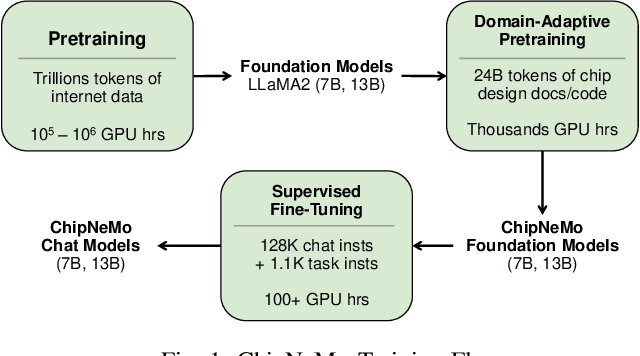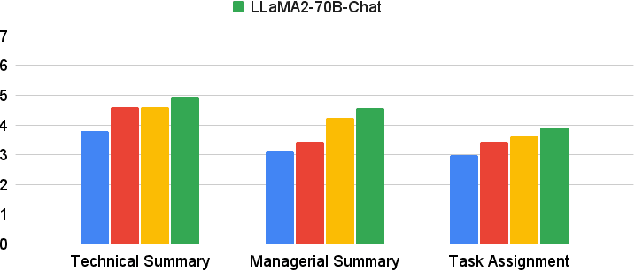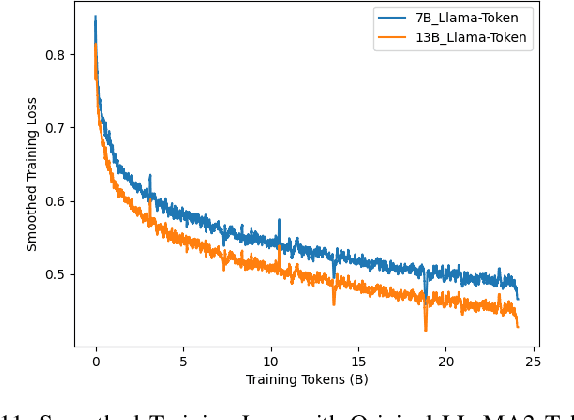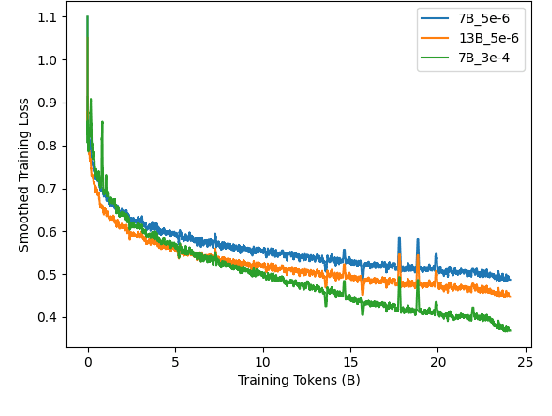Brucek Khailany
FGMP: Fine-Grained Mixed-Precision Weight and Activation Quantization for Hardware-Accelerated LLM Inference
Apr 19, 2025Abstract:Quantization is a powerful tool to improve large language model (LLM) inference efficiency by utilizing more energy-efficient low-precision datapaths and reducing memory footprint. However, accurately quantizing LLM weights and activations to low precision is challenging without degrading model accuracy. We propose fine-grained mixed precision (FGMP) quantization, a post-training mixed-precision quantization hardware-software co-design methodology that maintains accuracy while quantizing the majority of weights and activations to reduced precision. Our work makes the following contributions: 1) We develop a policy that uses the perturbation in each value, weighted by the Fisher information, to select which weight and activation blocks to keep in higher precision. This approach preserves accuracy by identifying which weight and activation blocks need to be retained in higher precision to minimize the perturbation in the model loss. 2) We also propose a sensitivity-weighted clipping approach for fine-grained quantization which helps retain accuracy for blocks that are quantized to low precision. 3) We then propose hardware augmentations to leverage the efficiency benefits of FGMP quantization. Our hardware implementation encompasses i) datapath support for FGMP at block granularity, and ii) a mixed-precision activation quantization unit to assign activation blocks to high or low precision on the fly with minimal runtime and energy overhead. Our design, prototyped using NVFP4 (an FP4 format with microscaling) as the low-precision datatype and FP8 as the high-precision datatype, facilitates efficient FGMP quantization, attaining <1% perplexity degradation on Wikitext-103 for the Llama-2-7B model relative to an all-FP8 baseline design while consuming 14% less energy during inference and requiring 30% less weight memory.
GauRast: Enhancing GPU Triangle Rasterizers to Accelerate 3D Gaussian Splatting
Mar 20, 2025Abstract:3D intelligence leverages rich 3D features and stands as a promising frontier in AI, with 3D rendering fundamental to many downstream applications. 3D Gaussian Splatting (3DGS), an emerging high-quality 3D rendering method, requires significant computation, making real-time execution on existing GPU-equipped edge devices infeasible. Previous efforts to accelerate 3DGS rely on dedicated accelerators that require substantial integration overhead and hardware costs. This work proposes an acceleration strategy that leverages the similarities between the 3DGS pipeline and the highly optimized conventional graphics pipeline in modern GPUs. Instead of developing a dedicated accelerator, we enhance existing GPU rasterizer hardware to efficiently support 3DGS operations. Our results demonstrate a 23$\times$ increase in processing speed and a 24$\times$ reduction in energy consumption, with improvements yielding 6$\times$ faster end-to-end runtime for the original 3DGS algorithm and 4$\times$ for the latest efficiency-improved pipeline, achieving 24 FPS and 46 FPS respectively. These enhancements incur only a minimal area overhead of 0.2\% relative to the entire SoC chip area, underscoring the practicality and efficiency of our approach for enabling 3DGS rendering on resource-constrained platforms.
BCQ: Block Clustered Quantization for 4-bit (W4A4) LLM Inference
Feb 07, 2025Abstract:Post-training quantization (PTQ) is a promising approach to reducing the storage and computational requirements of large language models (LLMs) without additional training cost. Recent PTQ studies have primarily focused on quantizing only weights to sub-8-bits while maintaining activations at 8-bits or higher. Accurate sub-8-bit quantization for both weights and activations without relying on quantization-aware training remains a significant challenge. We propose a novel quantization method called block clustered quantization (BCQ) wherein each operand tensor is decomposed into blocks (a block is a group of contiguous scalars), blocks are clustered based on their statistics, and a dedicated optimal quantization codebook is designed for each cluster. As a specific embodiment of this approach, we propose a PTQ algorithm called Locally-Optimal BCQ (LO-BCQ) that iterates between the steps of block clustering and codebook design to greedily minimize the quantization mean squared error. When weight and activation scalars are encoded to W4A4 format (with 0.5-bits of overhead for storing scaling factors and codebook selectors), we advance the current state-of-the-art by demonstrating <1% loss in inference accuracy across several LLMs and downstream tasks.
SQ-DM: Accelerating Diffusion Models with Aggressive Quantization and Temporal Sparsity
Jan 26, 2025Abstract:Diffusion models have gained significant popularity in image generation tasks. However, generating high-quality content remains notably slow because it requires running model inference over many time steps. To accelerate these models, we propose to aggressively quantize both weights and activations, while simultaneously promoting significant activation sparsity. We further observe that the stated sparsity pattern varies among different channels and evolves across time steps. To support this quantization and sparsity scheme, we present a novel diffusion model accelerator featuring a heterogeneous mixed-precision dense-sparse architecture, channel-last address mapping, and a time-step-aware sparsity detector for efficient handling of the sparsity pattern. Our 4-bit quantization technique demonstrates superior generation quality compared to existing 4-bit methods. Our custom accelerator achieves 6.91x speed-up and 51.5% energy reduction compared to traditional dense accelerators.
ESPACE: Dimensionality Reduction of Activations for Model Compression
Oct 07, 2024Abstract:We propose ESPACE, an LLM compression technique based on dimensionality reduction of activations. Unlike prior works on weight-centric tensor decomposition, ESPACE projects activations onto a pre-calibrated set of principal components. The activation-centrality of the approach enables retraining LLMs with no loss of expressivity; while at inference, weight decomposition is obtained as a byproduct of matrix multiplication associativity. Theoretical results on the construction of projection matrices with optimal computational accuracy are provided. Experimentally, we find ESPACE enables 50% compression of GPT3, Llama2, and Nemotron4 models with small accuracy degradation, as low as a 0.18 perplexity increase on GPT3-22B. At lower compression rates of 20% to 40%, ESPACE drives GPT3 models to outperforming their baseline, by up to a 0.38 decrease in perplexity for GPT3-8B. ESPACE also reduces GEMM execution time and prefill inference latency on existing hardware. Comparison with related works on compressing Llama2-7B via matrix factorization shows that ESPACE is a first step in advancing the state-of-the-art in tensor decomposition compression of LLMs.
Revisiting VerilogEval: Newer LLMs, In-Context Learning, and Specification-to-RTL Tasks
Aug 20, 2024Abstract:The application of large-language models (LLMs) to digital hardware code generation is an emerging field. Most LLMs are primarily trained on natural language and software code. Hardware code, such as Verilog, represents only a small portion of the training data and few hardware benchmarks exist. To address this gap, the open-source VerilogEval benchmark was released in 2023, providing a consistent evaluation framework for LLMs on code completion tasks. It was tested on state-of-the-art models at the time including GPT-4. However, VerilogEval and other Verilog generation benchmarks lack failure analysis and, in present form, are not conducive to exploring prompting techniques. Also, since VerilogEval's release, both commercial and open-source models have seen continued development. In this work, we evaluate new commercial and open-source models of varying sizes against an improved VerilogEval benchmark suite. We enhance VerilogEval's infrastructure and dataset by automatically classifying failures, introduce new prompts for supporting in-context learning (ICL) examples, and extend the supported tasks to specification-to-RTL translation. We find a measurable improvement in commercial state-of-the-art models, with GPT-4 Turbo achieving a 59% pass rate on spec-to-RTL tasks. We also study the performance of open-source and domain-specific models that have emerged, and demonstrate that models can benefit substantially from ICL. We find that recently-released Llama 3.1 405B achieves a pass rate of 58%, effectively matching that of GPT-4 Turbo, and that the much smaller domain-specific RTL-Coder 6.7B models achieve an impressive 37% pass rate. However, prompt engineering is key to achieving good pass rates, and varies widely with model and task. A benchmark infrastructure that allows for prompt engineering and failure analysis is key to continued model development and deployment.
VerilogCoder: Autonomous Verilog Coding Agents with Graph-based Planning and Abstract Syntax Tree (AST)-based Waveform Tracing Tool
Aug 15, 2024



Abstract:Due to the growing complexity of modern Integrated Circuits (ICs), automating hardware design can prevent a significant amount of human error from the engineering process and result in less errors. Verilog is a popular hardware description language for designing and modeling digital systems; thus, Verilog generation is one of the emerging areas of research to facilitate the design process. In this work, we propose VerilogCoder, a system of multiple Artificial Intelligence (AI) agents for Verilog code generation, to autonomously write Verilog code and fix syntax and functional errors using collaborative Verilog tools (i.e., syntax checker, simulator, and waveform tracer). Firstly, we propose a task planner that utilizes a novel Task and Circuit Relation Graph retrieval method to construct a holistic plan based on module descriptions. To debug and fix functional errors, we develop a novel and efficient abstract syntax tree (AST)-based waveform tracing tool, which is integrated within the autonomous Verilog completion flow. The proposed methodology successfully generates 94.2% syntactically and functionally correct Verilog code, surpassing the state-of-the-art methods by 33.9% on the VerilogEval-Human v2 benchmark.
ChipNeMo: Domain-Adapted LLMs for Chip Design
Nov 13, 2023



Abstract:ChipNeMo aims to explore the applications of large language models (LLMs) for industrial chip design. Instead of directly deploying off-the-shelf commercial or open-source LLMs, we instead adopt the following domain adaptation techniques: custom tokenizers, domain-adaptive continued pretraining, supervised fine-tuning (SFT) with domain-specific instructions, and domain-adapted retrieval models. We evaluate these methods on three selected LLM applications for chip design: an engineering assistant chatbot, EDA script generation, and bug summarization and analysis. Our results show that these domain adaptation techniques enable significant LLM performance improvements over general-purpose base models across the three evaluated applications, enabling up to 5x model size reduction with similar or better performance on a range of design tasks. Our findings also indicate that there's still room for improvement between our current results and ideal outcomes. We believe that further investigation of domain-adapted LLM approaches will help close this gap in the future.
VerilogEval: Evaluating Large Language Models for Verilog Code Generation
Sep 14, 2023Abstract:The increasing popularity of large language models (LLMs) has paved the way for their application in diverse domains. This paper proposes a benchmarking framework tailored specifically for evaluating LLM performance in the context of Verilog code generation for hardware design and verification. We present a comprehensive evaluation dataset consisting of 156 problems from the Verilog instructional website HDLBits. The evaluation set consists of a diverse set of Verilog code generation tasks, ranging from simple combinational circuits to complex finite state machines. The Verilog code completions can be automatically tested for functional correctness by comparing the transient simulation outputs of the generated design with a golden solution. We also demonstrate that the Verilog code generation capability of pretrained language models could be improved with supervised fine-tuning by bootstrapping with LLM generated synthetic problem-code pairs.
HEAT: Hardware-Efficient Automatic Tensor Decomposition for Transformer Compression
Nov 30, 2022Abstract:Transformers have attained superior performance in natural language processing and computer vision. Their self-attention and feedforward layers are overparameterized, limiting inference speed and energy efficiency. Tensor decomposition is a promising technique to reduce parameter redundancy by leveraging tensor algebraic properties to express the parameters in a factorized form. Prior efforts used manual or heuristic factorization settings without hardware-aware customization, resulting in poor hardware efficiencies and large performance degradation. In this work, we propose a hardware-aware tensor decomposition framework, dubbed HEAT, that enables efficient exploration of the exponential space of possible decompositions and automates the choice of tensorization shape and decomposition rank with hardware-aware co-optimization. We jointly investigate tensor contraction path optimizations and a fused Einsum mapping strategy to bridge the gap between theoretical benefits and real hardware efficiency improvement. Our two-stage knowledge distillation flow resolves the trainability bottleneck and thus significantly boosts the final accuracy of factorized Transformers. Overall, we experimentally show that our hardware-aware factorized BERT variants reduce the energy-delay product by 5.7x with less than 1.1% accuracy loss and achieve a better efficiency-accuracy Pareto frontier than hand-tuned and heuristic baselines.
 Add to Chrome
Add to Chrome Add to Firefox
Add to Firefox Add to Edge
Add to Edge